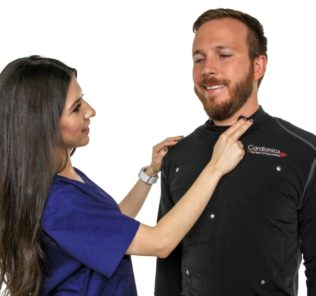VentriloCAST Provides Remote Simulation Auscultation Stethoscopes
Lecats’s Ventriloscope has developed a healthcare simulation training accessory known as VentriloCAST, which enables Ventriloscope’s High- Fidelity Simulation Auscultation Stethoscopes the ability to broadcast normal and abnormal sounds over a Zoom or any video conferencing app. The VentriloCAST accessory is easy to connect, inexpensive and requires no ongoing operating costs. This is especially useful for clinical simulation educators adopting Telesimulation in an effort to keep learners engaged during the coronavirus/COVID-19 pandemic. The VentriloCAST is undoubtedly helping to advance the “new look” of high-fidelity simulation during and after the Coronavirus pandemic.
The Ventriloscope is a robust high-fidelity simulation stethoscope paired with a handheld transmitting device that casts a digitally recorded real patient abnormal sound back to the simulation stethoscope. The solution also has the ability to accept any sound recorded as an MP3 audio file, giving the user unlimited teaching capabilities. The LIVE head on the Ventriloscope can also be used to hear a standardized patient’s real anatomical sounds or a sound produced from a manikin for further identification and comparison.
Adding to this solution, the VentriloCAST is a telesimulation accessory that connects the Ventriloscope’s handheld transmitter device directly to a smart device or PC. The healthcare simulation educator now has the ability to simultaneously send the abnormal sound to the Ventriloscope and or into the Zoom or any web-based conference. VentriloCAST can also be used to send sounds through the institution’s video debriefing system, allowing them to be recorded for review or live feed of a clinical simulation.
Sponsored Content:
Reinforcing Patient Safety Through Retention
The stethoscope is one of the most fundamental tools for healthcare professionals and can be one of the most powerful in the initial detection of cardiac or pulmonary illness. Teaching students by process rather than memorization enhances scientific knowledge and allows concepts to be more memorable and generalizable (Fischer, 2011).
By teaching students a logical and clinically relevant process to go through, students identify sounds at a significantly higher rate and display more confidence when doing so.
“I have been using the Ventriloscope in my assessment workshops that I conduct during the semester, and I am happy to say that I absolutely love using it! The students are awestruck by its capabilities; it really adds realism into a classroom and opens up a wide range of active learning and different learning styles,” one Ventriloscope user shared.
Sponsored Content:
Diagnostic Errors Leading to Malpractice Suits
According to a recent five-year study of closed medical malpractice claims, diagnostic errors are the leading cause of liability claims against primary care doctors; they account for the highest proportion of payouts. The study was conducted by Coverys, a Boston-based medical liability insurer, which analyzed over 1800 claims brought against primary care physicians.
The study found that diagnostic errors accounted for 46% of total claims and accounted for the highest proportion of indemnity paid – 68%. Even more alarming, 45% of injuries in diagnosis-related cases resulted in a patient’s death. Cancer was the top condition associated with a diagnostic failure, responsible for 50% of diagnosis-related claims. According to the report, the most commonly missed cancer diagnoses were colorectal (20%), lung (19%), prostate (11%), bladder (9%) and breast (8%).
After cancer, the top conditions where a diagnostic error occurred were infections (19%), cardiac/vascular (16%), and myocardial infarction-related injuries (11%). Where did the diagnostic breakdowns take place? The study found three areas where errors take place and improvements can be made:
- Taking a complete family history and doing a thorough physical exam
- Ordering diagnostic and lab tests
- Making referrals
After diagnostic errors, treatment-related claims are the second most common claims against primary care physicians, particularly allegations about the overall management of treatment, followed by failure to treat. Medication-related claims, particularly with high-risk medications such as opioids and anticoagulants, often result in high payouts.
The study noted that physicians could help protect themselves by being more careful during transitions in care, closing referral loops, and performing complete, age-appropriate physical exams, including cancer screening. By using Lecats’s Ventriloscope and the VentriloCAST accessory, learners and professionals can use high-fidelity simulation to ensure that they are properly training to avoid medical error while increasing the safety of their patients.
“Our goal is to stress the importance of proper physical examinations and diagnosis. We believe that the next frontier in mortality reduction will come by training people to recognize crucial findings and act early to prevent the next code,” said Dr. Paul Lecat MD, FACP, FAAP.
The Ventriloscope has currently been adopted in over 475 schools across 34 countries for training paramedics, nursing students, medical residents and even practicing physicians. The company will soon be expanding its product offering in 2021 geared toward reinforced remote learning applications.
Learn More About the VentriloCAST Here!
Lance Baily, BA, EMT-B, is the Founder & CEO of HealthySimulation.com, which he started while serving as the Director of the Nevada System of Higher Education’s Clinical Simulation Center of Las Vegas back in 2010. Lance is also the Founder and acting Advisor to the Board of SimGHOSTS.org, the world’s only non-profit organization dedicated to supporting professionals operating healthcare simulation technologies. His co-edited Book: “Comprehensive Healthcare Simulation: Operations, Technology, and Innovative Practice” is cited as a key source for professional certification in the industry. Lance’s background also includes serving as a Simulation Technology Specialist for the LA Community College District, EMS fire fighting, Hollywood movie production, rescue diving, and global travel. He and his wife Abigail Baily, PhD live in Las Vegas, Nevada with their two amazing daughters.
Sponsored Content:




















